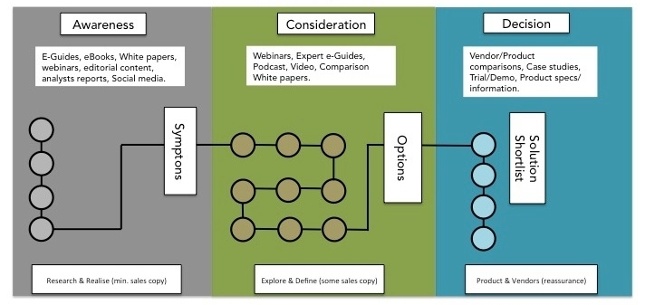What’s wrong with how we build the traditional B2B sales funnel?

The B2B buying path has rapidly evolved in recent years, as buyers delay until much later in their buying journey to interact directly with a vendor.
With knowledge comes power, and as buyers know what they want having researched a solution they are more assertive in their behaviour, shutting down conversations early from unwanted sales approaches.
Buyers are more selective that ever before and don’t need to hear from a brand directly to make a buying decision. And that’s a problem, because the traditional approach to doing business that many companies are hanging on to are not effective, as buyers filter out advertising clutter or the direct sales approach.
With these changes in how buyers research their purchases, buyer behaviour is moving outside of the confines of the traditional definition of a linear sales funnel.
In today’s market, 67% of the buyers journey is now done digitally and buyers actively seek to self-educate and acquire knowledge online.
When you consider these changes in the B2B buying behaviour, it makes sense that it can be difficult to reach an audience through the traditional marketing methods. And with so many advertising messages bombarding us, it’s no wonder that we are filtering them out. Buyers are shifting away from the traditional outbound marketing toward a two-way conversation built on engagement and satisfying a buyers needs. Transforming selling to match the way people want to buy by using the inbound sales and marketing approach.
The end of the traditional sales funnel?
Generating awareness for your brand is designed to attract leads into the top of the sales funnel, to start a prospective customer’s journey down the funnel and into the sales pipeline.
The problem with the sales funnel conversation is that it describes a funnel with a definite end – buy or not buy. If you don’t buy, you must be either stuck in the middle or fallen out of the bottom. A common mistake is to assume that if a visitor doesn’t progress from one stage to the next that they must have dropped out and disappeared.
Moving from one stage to another in the funnel, entering and leaving at different points, is contrary to the idea of a traditional funnel – which has only two openings, one at the top and one at the bottom and fails to track any leakage.
Today a sales prospects is moving across multiple devices and channels, as they jump into and out of the funnel, behaviour which has changed with the buyer’s journey now going predominantly digital.
In the same sales funnel you’ll have visitors entering part way through the funnel, some will exit early, some will skip stages, and others will engage multiple times at the same stage – all in a non-linear way. There are as many different buying journeys in the funnel as there are buyers.
What is the value of a sales funnel?
The traditional sales funnel maps the buying journey from prospect to customer. Although it is typically called a sales funnel, marketing has always been at its core. The concept of the classic sales funnel dates back centuries and offers a simple metaphor to making a purchase.
The chart below shows the buying journey (from Awareness to Decision) that your B2B sales prospects theoretically take.

A funnel visualises the customer journey and can be used as a tool to direct your efforts accordingly, depending on the stage that a visitor is at. For example, it won’t make much sense to talk about product features at the beginning of your conversation when visitors are not familiar or aware of your product or don’t realise that they actually have a need that you can meet.
The sales funnel does take on a different appearance for each business owner, but we tend to think in common terms of top of the funnel (TOFU), middle of the funnel (MOFU) and bottom of the funnel (BOFU).
The funnel traditionally has followed the process of a visitor starting at the top and the aim is to get them to the bottom, ready to make a purchase.

A sales funnel, the path to purchase, the buyers journey and customer journey mapping are to a great extent interchangeable. As they all refer to a series of channels that customers touch from prospect to purchase.
Typically all of these approaches cover the following buyer stages:
- Contemplation
- Research
- Purchase
- Post purchase
The sales funnel will always be an integral part of journey mapping, but just because your customer has reached the end of the funnel it does not mean the end of a customer’s journey.
So what is wrong with the sales funnel?
Focusing on a simple funnel to develop your sales strategy can be limiting. It is easy to take a short term view and forget about building value and an engaging relationship after the initial sale.
A common mistake is to assume that if a visitor doesn’t progress from one stage to the next that they must have left the funnel. However, there will be some visitors who are not quite convinced by your arguments, they are interested but not ready to make a move just yet.
To be able to stimulate these visitors, you’re going to have to increase the impact that your content provides and at the same time make sure you keep interested visitors moving between stages with activities that nurture and build trust.
A lot of businesses focus their content marketing efforts solely on filling the top of the funnel to increase website traffic. But what happens once someone has travelled through the funnel? Once a visitor has done what you wanted – made a purchase, what happens next?
With B2B buyers predominantly doing their own research, critics have suggested it is time to modify the traditional view of the sales funnel.
A business cannot assume in our digital world that all visitors start from the same place, move through the same steps, and finish at the same end-point. Fluidity is contrary to the idea of a traditional funnel which has only two openings, one at the top and one at the bottom but ignores possible leakage through other places.
Prospects do not tend to unilaterally enter the sales funnel at the top, then methodically work their way through each stage and, then drop into the final stages to make a purchase. It’s too simplistic an approach to build a funnel around the beginning, middle and end path.
It’s time to transform your approach
At each stage in the funnel leads and prospects seek control of the process and actively “pull” information through online resources to learn more. It is at these stages that the content marketing efforts pay off, as the change in the way buyers make decisions means educating rather than selling is a more effective tactic.
Many companies focus on either end of the funnel — building awareness at the top or closing sales at the bottom. Understanding more about your customers by creating a buyer persona reveals the format, style and communication preferences of your buyers. Knowing which touch points have the potential to influence a particular lead can direct your sales and marketing efforts.
Celebrate what makes your business different
If a visitor to your website can’t identify your company’s unique value within those first 3 seconds of being on your homepage, chances are you’ve already lost their interest and their business.
When visitors first arrive on your site, you need to tell them exactly what makes you different and what problem you are going to solve to help them succeed.
A good way to address a new visitor is to prominently place your value proposition:
- What you do
- Who you do it for
- How you do it differently
Your brand’s unique personality should help to differentiate your business from the competition, it’s easy for a competitor to copy your pricing strategy but difficult to copy your brand story.
So when it comes to using the sales funnel, you need to think in terms of what works for your business rather than just adopting the traditional funnel and some of the limitations it brings.
I hope I have managed to get you thinking about who your customers are, and the journey they take to reach you.
Download our Buyer’s Personas templates and guide, to get you started and focused on your customers pain and hopefully what will be your gains or if you want to know more about how to build a lead generation pipeline download our e-guide below.
